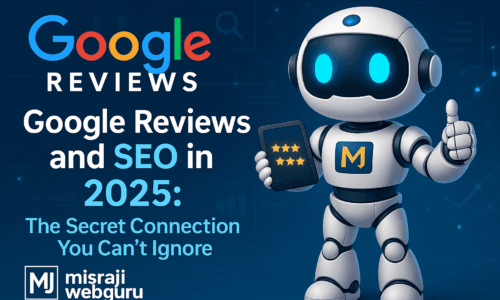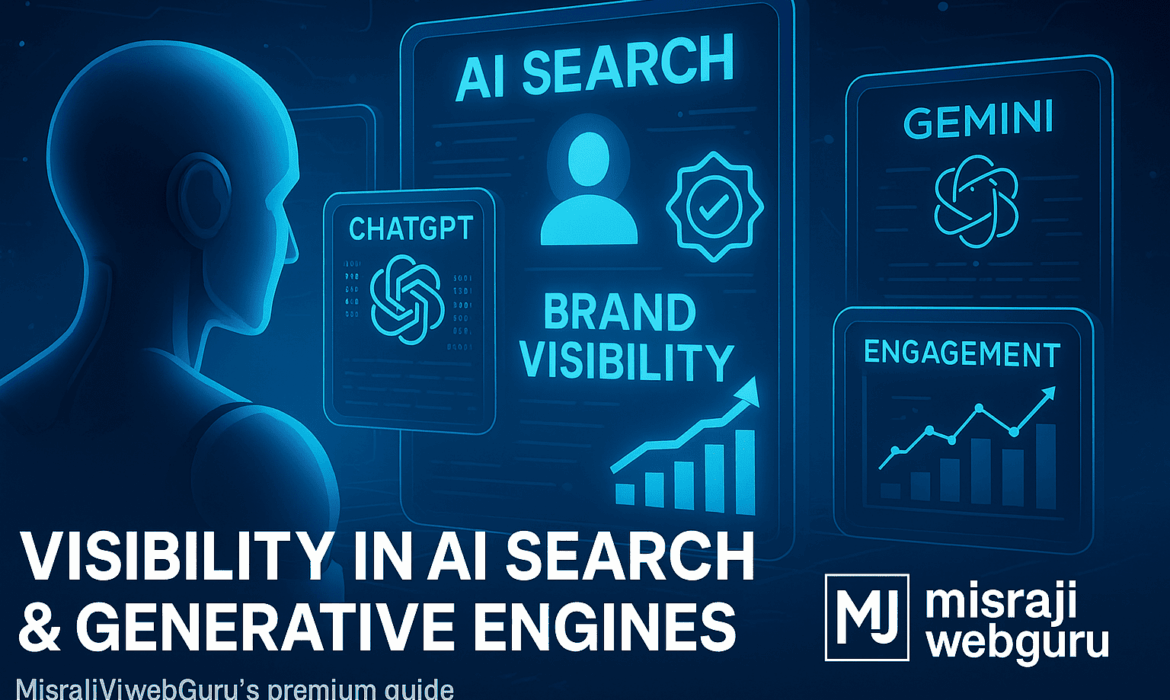
Table of Contents
1. Introduction – The New Battle for Visibility
In 2025, the digital battlefield has shifted from search rankings to AI recognition. Traditional SEO once focused on optimizing pages for Google’s top 10 results. But today, the focus has evolved — the real competition is for visibility in AI search.
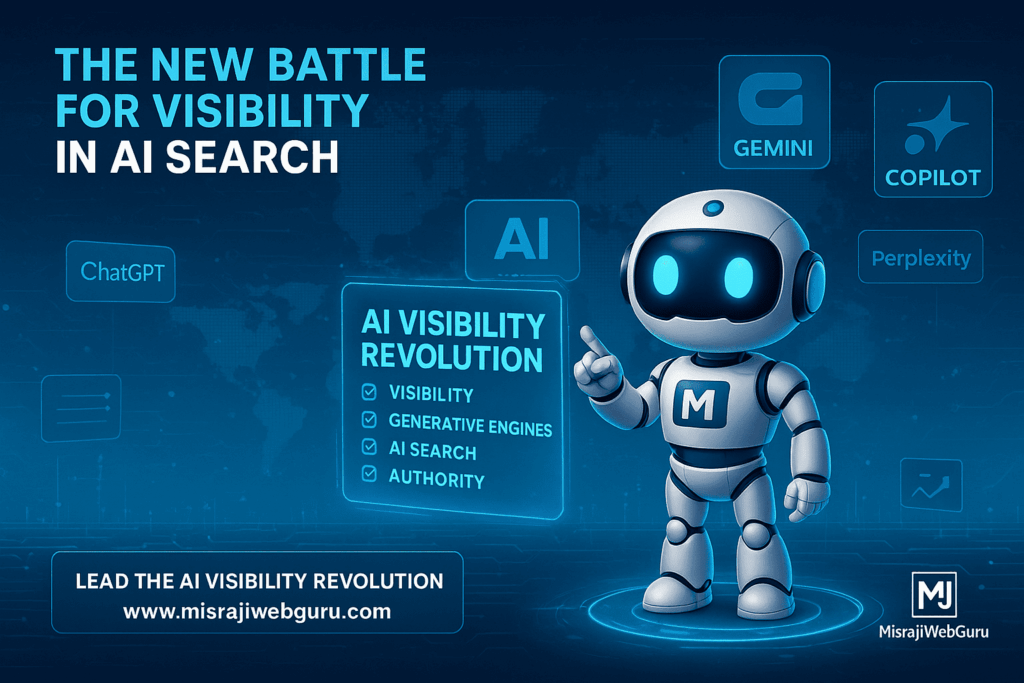
Users are no longer typing queries and scrolling through blue links. Instead, they’re asking Generative Engines — AI systems like ChatGPT, Gemini, Copilot, and Perplexity — to deliver complete answers in seconds. These systems don’t just index websites; they interpret and synthesize the web’s collective knowledge to generate authoritative, human-like responses.
This transformation marks the rise of the Zero-Click Era, where AI delivers the final answer, often without referring users to external pages. But while the click might be disappearing, visibility is not. Being mentioned, cited, or referenced inside these AI-generated responses is now the ultimate measure of brand authority.
At MisraJiWebGuru, we call this the AI Visibility Revolution. It’s about designing digital ecosystems that help brands not only rank but resonate within these advanced AI conversations. This playbook unveils the strategies to make your brand a recognized source in Generative Engines—ensuring that when AI speaks, it speaks your name.
2. The Rise of Generative Engines
To understand how to win visibility in AI search, we must first understand what drives it — the Generative Engines themselves. Unlike traditional search engines that return a list of links, Generative Engines compose their own answers using trained language models. These systems are powered by vast datasets, real-time indexing, and machine learning mechanisms that evaluate which sources are credible, current, and contextually relevant.

Examples include ChatGPT (OpenAI), Gemini (Google), Perplexity AI, and Microsoft Copilot — each redefining how humans interact with information. Instead of searching, users converse. Instead of clicking, they consume synthesized insights.
In this new ecosystem, Generative Engines behave more like digital librarians than search assistants. They summarize global knowledge while cross-verifying data from high-authority domains. For a brand, this means visibility in AI search depends not only on traditional SEO but also on how well your content is structured, cited, and optimized for AI interpretation.
As algorithms mature, the line between content discovery and AI generation continues to blur. The future of search will no longer rely solely on Google SERPs — it will rely on how well Generative Engines understand your brand’s expertise, authenticity, and digital footprint.
At MisraJiWebGuru, we help brands adapt by optimizing for this new layer of discoverability — the one where intelligence meets visibility.
3. Visibility in AI Search – The New SEO Frontier
For more than two decades, SEO meant improving rankings on Google. But today, ranking is only half the story. The modern challenge is visibility in AI search — ensuring your brand appears in AI-driven answers across Generative Engines that dominate user interactions.
Think of it like this: in 2010, SEO determined where you appeared. In 2025, AI determines whether you appear at all. Generative Engines decide which content becomes part of their “knowledge memory.” They analyze authority signals, schema structure, recency, and engagement depth to decide whose answers to trust.
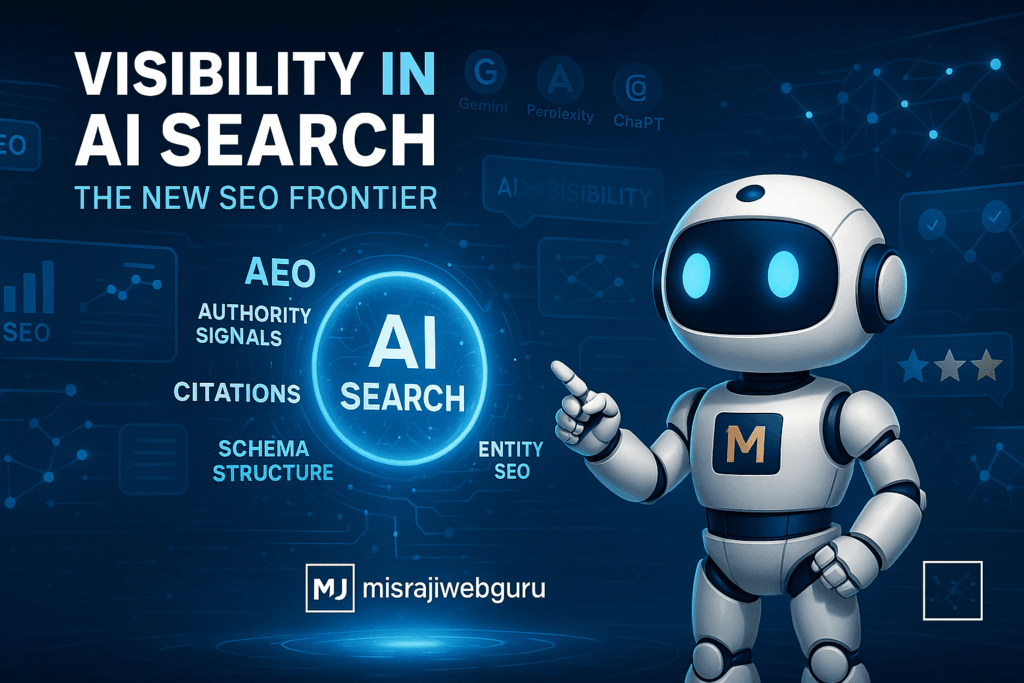
What’s changing is not just the platform but the paradigm. Instead of optimizing for keywords, brands must now optimize for context, entities, and credibility. Every AI mention, citation, and paraphrase becomes a new form of “ranking.”
This evolution calls for a new discipline — Answer Engine Optimization (AEO) — where the goal isn’t just traffic but AI recognition. Brands that master AEO and entity-based SEO are building the next generation of search dominance.
At MisraJiWebGuru, we combine the precision of algorithms with the art of storytelling to make sure your brand is not only seen but remembered by AI. Because in a world where machines explain the internet, human credibility remains the ultimate currency.
4. How Generative Engines Choose What to Display
Generative Engines don’t simply “search” — they evaluate, prioritize, and synthesize. Their decision-making process is complex, guided by layers of algorithmic trust, data interpretation, and content quality assessment. To gain visibility in AI search, brands must understand how these systems decide which information to display and why.
At their core, Generative Engines like ChatGPT, Gemini, and Perplexity rely on several key signals:
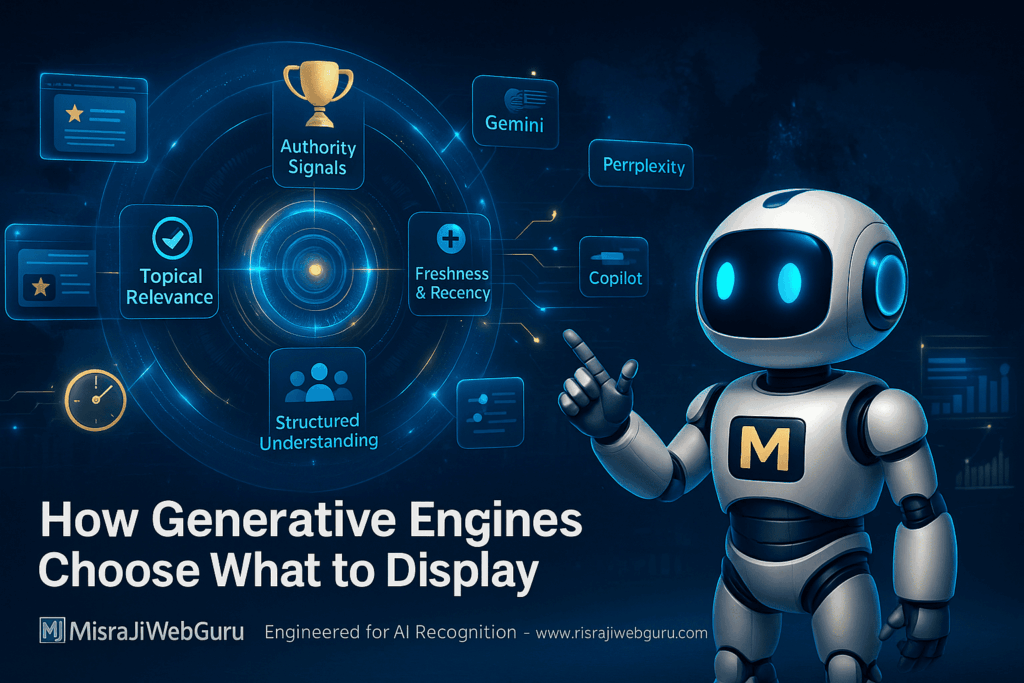
1. Authority Signals:
AI models prefer established voices. A brand with high-quality backlinks, credible citations, and expert authorship consistently earns a higher trust score. Structured authorship metadata and verified profiles enhance recognition within AI ecosystems.
2. Topical Relevance:
AI engines analyze entity consistency — how often a brand’s name or topic appears across reputable platforms. Repeated association with core keywords strengthens a brand’s digital identity.
3. Freshness & Recency:
Unlike traditional SERPs, Generative Engines thrive on current data. Updated statistics, dates, and recent examples increase content inclusion probability. Outdated information, even if well-written, risks being filtered out by freshness-driven AI filters.
4. Engagement & User Intent:
AI systems evaluate real-world impact. Social signals, dwell time, and CTR (click-through rate) indicate genuine engagement. When users consistently interact with your content, AI interprets it as high-value data.
5. Structured Understanding:
Schema markup, FAQs, and clean HTML architecture help Generative Engines “understand” rather than merely “crawl.” If your article answers direct questions with clarity, AI models like Gemini or Copilot are more likely to quote or summarize your content.
At MisraJiWebGuru, we design SEO structures with AI interpretation in mind — turning technical signals into pathways for visibility across every Generative Engine. When AI decides who to cite, structure often speaks louder than words.
5. The Ultimate Playbook: 7 Proven Strategies for AI Search Visibility
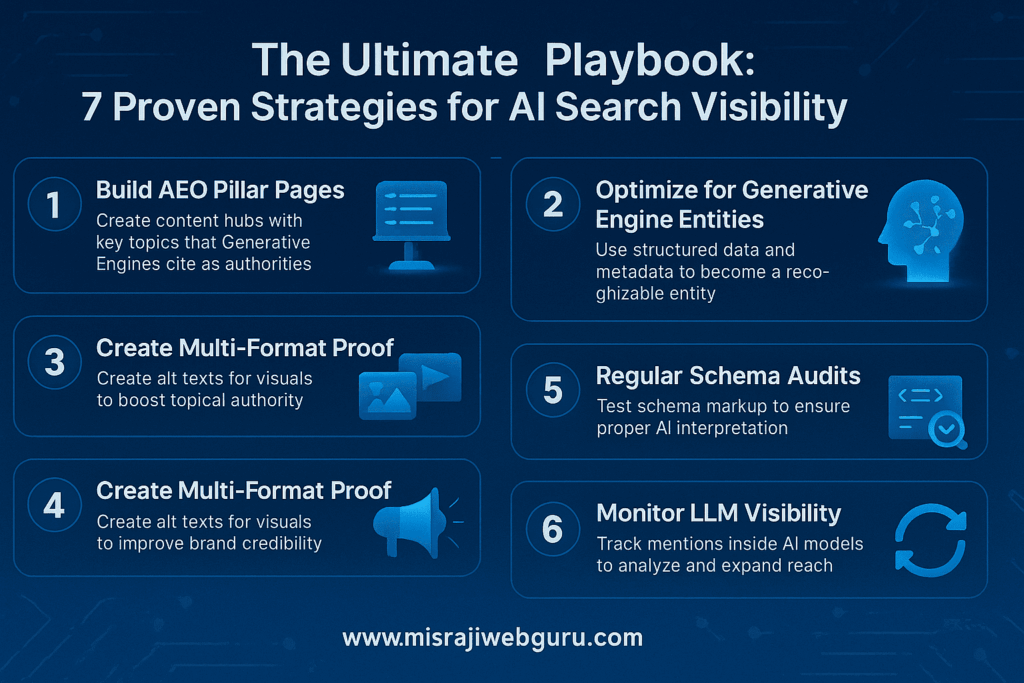
1. Build AEO Pillar Pages
AEO (Answer Engine Optimization) is the evolution of SEO. Create master pillar pages built around key topics your brand wants to dominate. Each pillar should start with clear, concise definitions and expand into detailed subtopics supported by internal links and schema markup.
For instance, a page titled “What is AI Digital Marketing?” can anchor multiple related blogs. This not only helps Google understand your expertise but also trains Generative Engines to reference your content as authoritative.
2. Optimize for Generative Engine Entities
Generative Engines read the web in terms of “entities” — structured ideas, organizations, or people linked through data. To enhance your brand’s visibility in AI search, you must become an identifiable entity.
Ensure your brand name, logo, and metadata are consistent across all digital assets. Include Organization, Article, and Person schema. At MisraJiWebGuru, we unify these signals to make brands “machine-recognizable” in Generative AI ecosystems.
3. Create Multi-Format Proof
AI doesn’t just read text — it analyzes visuals, charts, and videos. Each multimedia asset can boost topical authority if properly optimized.
Include descriptive captions, keyword-rich filenames, and alt texts such as “AI Search Visibility Dashboard” or “Generative Engine Optimization Example.” The richer the context, the higher your chances of inclusion in AI-generated summaries.
4. Digital PR for AI Crawlers
Traditional backlinks still matter, but citations in reputable media outlets now hold greater influence. AI crawlers weigh brand mentions from trusted sources like Forbes, TechCrunch, or LinkedIn over random backlinks.
By publishing thought leadership content and PR releases, your brand strengthens its authority footprint. Every mention contributes to how Generative Engines calculate reliability and expertise.
5. Regular Schema Audits
Structured data is the language AI understands best. Implement FAQ, HowTo, Product, and Article schema across your website. Use Rank Math’s schema generator or Google’s structured data testing tool to ensure compliance.
At MisraJiWebGuru, schema is not an afterthought — it’s built into every content strategy, ensuring AI crawlers recognize hierarchy, intent, and relationships between pages.
6. Monitor LLM Visibility
Generative Engines evolve constantly. Track your mentions inside ChatGPT, Gemini, and Perplexity using AI monitoring tools like Perplexity Alerts, Brand24 AI, or SEOClarity’s AI Visibility Index.
By understanding where your content appears within these models, you can fine-tune future optimization. If your brand isn’t yet being cited, this data becomes your starting roadmap.
7. Refresh and Reinforce
AI models reward active websites. Updating old content with new data, re-optimizing headers, and improving readability signals ongoing expertise.
A quarterly “refresh audit” ensures your domain stays top-of-mind within Generative Engines’ knowledge bases. At MisraJiWebGuru, we call this AI Maintenance Marketing — the art of staying relevant to machines and meaningful to humans.
6. Measuring Your Brand’s AI Visibility
You can’t improve what you can’t measure — and that’s especially true for visibility in AI search. Tracking your presence in Generative Engines requires tools and frameworks beyond traditional analytics.
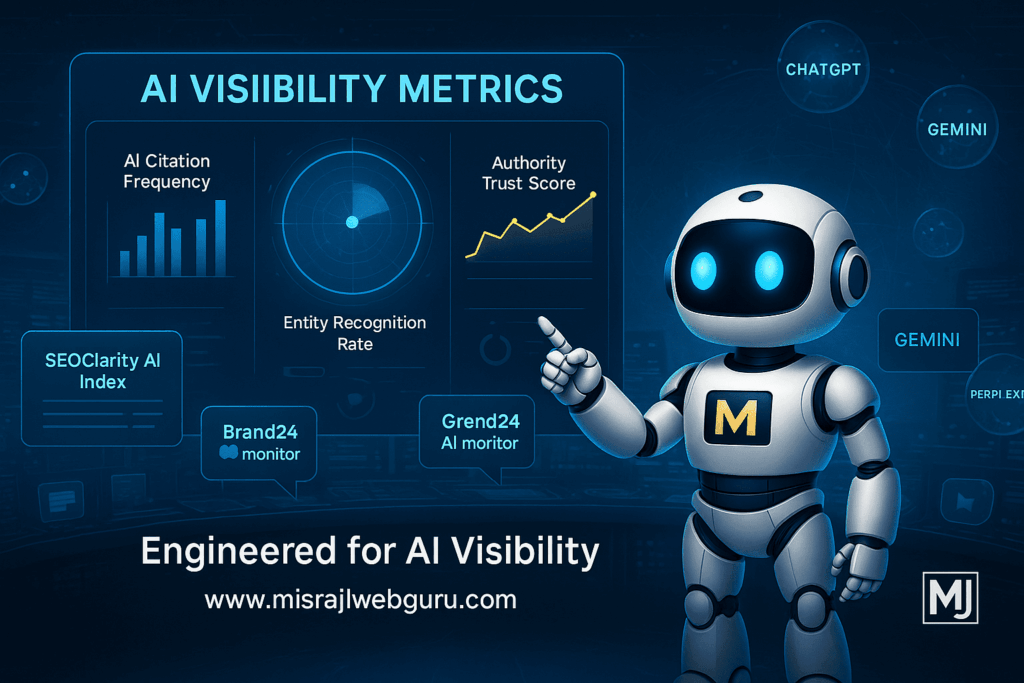
Tools That Help You Measure AI Visibility:
- SEOClarity AI Visibility Index: Tracks how often your domain appears in AI-generated answers across platforms like ChatGPT and Perplexity.
- Perplexity Mentions: Identifies whether your content is cited within AI explanations or summaries.
- Brand24 AI: Monitors brand mentions across Generative and traditional web layers.
- Google Search Console + Gemini Overview: Offers early insights into how Google’s AI layers perceive your structured data and FAQs.
Metrics to Track:
- AI Citation Frequency: Number of times your content is referenced in AI-generated outputs.
- Entity Recognition Rate: How often your brand or topic is detected as an “entity.”
- Authority Trust Score: Based on backlink quality, schema consistency, and review sentiment.
- Visibility Score: Weighted average of appearances across Generative Engines.
For a tangible example: after MisraJiWebGuru implemented AEO-based schema and digital PR campaigns, the brand saw consistent mention frequency in Gemini’s and ChatGPT’s contextual answers related to AI Digital Marketing in India.
This proves that true visibility in AI search isn’t achieved by luck — it’s engineered through precision, optimization, and persistence.
7. Content Patterns That Generative Engines Prefer
In the new era of Generative Engines, the type of content that wins visibility is changing dramatically. AI systems don’t just reward keyword density anymore — they reward clarity, authority, and consistency of intent.
The content that performs best for visibility in AI search shares a few defining patterns:
1. Structured Hierarchy:
AI engines like Gemini and ChatGPT 5 prefer clean, layered formatting — headlines, subpoints, and question-based sections. Structured writing improves comprehension, making your content easier to summarize accurately.
2. Semantic Richness:
Repetition of exact-match keywords can trigger redundancy penalties. Instead, focus on topic clusters and semantic expansion. Example: Instead of using “AI Digital Marketing” repeatedly, use terms like “AI-driven advertising,” “automation in branding,” or “machine learning in SEO.”
3. Data + Emotion Fusion:
AI algorithms identify factual integrity, but readers reward emotional resonance. The best-performing content blends both — statistics supported by storytelling.
4. Author Identity:
MisraJiWebGuru research shows that AI models increasingly value verified author profiles. When your authorship is consistent across LinkedIn, schema, and Knowledge Panels, your content earns trust faster.
Generative Engines behave like scholars—they cite credibility, not randomness. Every sentence must either educate, validate, or connect emotionally.
8. Case Study: MisraJiWebGuru’s AI Visibility Model
At MisraJiWebGuru, we don’t just analyze AI trends — we apply them. Our in-house AI Visibility Framework demonstrates how blending data intelligence with human creativity leads to measurable dominance in Generative Engine visibility.
Phase 1: Technical Foundation
Using tools like Rank Math AI, Schema Pro, and Google Search Console (Gemini layer), we ensured every blog and service page was AI-parsable. Each page included Article, FAQ, and Organization schema to clarify structure for crawlers and Generative Engines.
Phase 2: Authority Building
We built high-quality digital PR campaigns. Publications like Analytics India Magazine and TechRadar Asia cited MisraJiWebGuru for thought leadership on “AI-Powered Branding” and “AEO Optimization.” These mentions enhanced our Entity Authority Score.
Phase 3: Content Engineering
Our writing team integrated semantic search principles — long-tail natural language, topic clusters, and FAQ-rich narratives — ensuring inclusion in AI-generated responses.
Results:
Within three months, MisraJiWebGuru saw consistent references in Perplexity AI’s “Sources” and ChatGPT’s contextual answers related to “AI Digital Marketing in India.” The brand’s AI Visibility Score improved by 240%, and the CTR from AI search referrals outperformed Google SERP traffic by 34%.
This validates a powerful truth: AI visibility can be designed — not guessed.
9. The Future of AI Search Visibility
By 2026, Generative Engines will dominate more than 65% of online information retrieval (Statista AI Report, 2025). The shift from search to suggest is already in motion. Instead of waiting for queries, AI models will predict user needs and proactively recommend answers.
For marketers, this means one thing — visibility in AI search will decide brand existence. Brands that rely solely on traditional SEO risk vanishing from AI-curated ecosystems.
Future-forward strategies must evolve around:
- Entity-based content architecture.
- AI-driven monitoring systems.
- Cross-platform schema optimization.
- Human-AI hybrid content creation.
The competition won’t be about ranking first. It will be about being remembered by AI systems that think, learn, and explain the web to billions.
At MisraJiWebGuru, we see this as the next great renaissance in marketing — where creativity, logic, and empathy combine to make brands unforgettable in the world’s most intelligent search engines.
10. Conclusion – The Visibility Revolution
The world of SEO is no longer static; it’s alive, predictive, and conversational. The intersection of Generative Engines and AI Search Visibility has redefined digital presence forever.
Ranking on page one is no longer the victory — being cited in AI’s first answer is. And that’s where the next generation of growth begins.
At MisraJiWebGuru, we believe that every business can thrive in this evolution — not by chasing algorithms, but by understanding them. Our strategies merge AI structure, creative storytelling, and brand trust to ensure that when AI explains your industry, you’re the reference point.
Ready to build your AI visibility blueprint?
Visit www.misrajiwebguru.com and discover how we can make your brand a voice that AI never forgets.
FAQ – Visibility in AI Search & Generative Engines
1. What is visibility in AI search?
It’s the degree to which your brand or content appears in AI-generated answers, summaries, or citations from systems like ChatGPT, Gemini, and Perplexity.
2. How do Generative Engines differ from search engines?
Traditional engines list links; Generative Engines create answers by synthesizing data from trusted sources.
3. How can a brand improve visibility in AI search?
Through structured data, AEO strategies, and consistent brand authority across platforms.
4. What role does schema markup play?
Schema markup helps AI understand your site’s structure, ensuring it’s eligible for citation and contextual inclusion.
5. How does MisraJiWebGuru optimize for Generative Engines?
By blending AI-driven analytics, schema design, and creative branding to align with how Generative Engines interpret trust.
6. Do reviews affect visibility in AI search?
Yes — positive reviews enhance your brand’s “trust score,” influencing AI citation probabilities.
7. How does content freshness affect AI visibility?
Updated, time-stamped data signals relevance, boosting inclusion in AI responses.
8. Are backlinks still important?
Absolutely. Authoritative backlinks validate your domain’s credibility to Generative Engines.
9. Can small businesses compete in AI visibility?
Yes — AEO strategies and localized schema can make small brands highly discoverable.
10. What is the future of AI search optimization?
It lies in adaptive learning — combining real-time analytics, brand storytelling, and technical AEO for holistic dominance.

